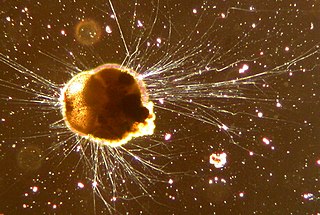Related Research Articles

Foraminifera are single-celled organisms, members of a phylum or class of amoeboid protists characterized by streaming granular ectoplasm for catching food and other uses; and commonly an external shell of diverse forms and materials. Tests of chitin are believed to be the most primitive type. Most foraminifera are marine, the majority of which live on or within the seafloor sediment, while a smaller number float in the water column at various depths. Fewer are known from freshwater or brackish conditions, and some very few (nonaquatic) soil species have been identified through molecular analysis of small subunit ribosomal DNA.

The Globigerinina is a suborder of foraminiferans that are found as marine plankton. They produce hyaline calcareous tests, and are known as fossils from the Jurassic period onwards. The group has included more than 100 genera and over 400 species, of which about 30 species are extant. One of the most important genera is Globigerina; vast areas of the ocean floor are covered with Globigerina ooze, dominated by the shells of planktonic forms.

The Rotaliida are an order of Foraminifera, characterized by multilocular tests (shells) composed of bilamellar perforate hyaline lamellar calcite that may be optically radial or granular.

Joseph Augustine Cushman was an American geologist, paleontologist and foraminiferologist.

Elphidium is an abundant genus of foraminifera. Species can be found from coastal regions out to the continental slope, and in all temperature ranges. Like other forams, fossils from different species are used to date rocks. The taxonomy of the species within this genus is disputed due to the high variability of some species.
Miliamellus is a genus of Cenozoic benthic foraminifera with tests made of imperforate opaline silica. It is the only genus in the order Silicoloculinida and the family Silicoloculinidae. It is sometimes referred to by the junior synonym Silicoloculina.

Cibicides is a genus of cosmopolitan benthic foraminifera known from at least as far back as the Paleocene that extends down to the present.

Cassidulina is a genus of foraminifera described in the Treatise Part C., as having a free, lenticular test, with central boss of clear calcite on either side. Chambers are biserially arranged, enrolled planispirally with a subangular to keeled periphery. The wall is calcareous, hyaline (glassy), optically granular, perforate. The surface is smooth with a polished appearance. Sutures are radial to oblique, straight or curved. The aperture is a narrow arched slip at the base of the apertural face, partly closed by an apertural place.
Discorbis is a genus of benthic Foraminfera, that made its first appearance during the Eocene. Its present distribution is cosmopolitan.
Rosalina is a genus of foraminifera included in the rotaliid family Rosalinidae.
Astrononion is a genus of foraminifera in the family Nonionidae, characterized by an evolute planispiral test with radially stellate structures partly covering the sutures on either side. The test is free, bilaterally symmetrical; periphery broadly rounded; chambers distinct, separated by depressed radial sutures, increasing gradually in size, and usually inflated; aperture a low arched opening at the base of the face of the test. The wall is of finely perforate monolamellar granular calcite.
Triloculina is a genus of foraminifera in the order Miliolida, included in the Quinqueloculininae. The test is three, chambers each a half coil in length. Early chambers, at least in the microspheric generation, in quinqueloculinan arrangement, later becoming triloculine with successive chambers added in planes 120 degrees apart. Only the final three chambers are visible externally. The aperture is terminal, at the end of the final chamber, with a bifid tooth in adult forms. As with the entire order, the test is composed of imperforate, porcelaneous calcite.

Allan Wie Hwa Bé was a micropaleontologist. He was considered a pioneer in research about planktonic foraminiferal ecology. He also served as president of the Cushman Foundation for Foraminiferal Research.
Globigerinoides is an extant genus of shallow-water planktonic foraminifera of family Globigerinidae. First appearing in the Oligocene these foraminifera are found in all modern oceans. Species of this genus occupy the euphotic zone, generally at depths between 10-50m, in waters which cover a range of salinities and temperatures. They are a shorter lived species, especially when compared to Globorotalia genus. As a genus Globigerinoides is widely used in various fields of research including biostratigraphy, isotope geochemistry, biogeochemistry, climatology, and oceanography.
Alfred R. ("Al") Loeblich Jr (1914–1994) was an American micropaleontologist. He was married to Helen Niña Tappan Loeblich and the two co-authored a number of important works on the Foraminifera and related organisms.
Globocassidulina is a genus of foraminifera.

Cyclammina is a genus of foraminifers in the family Cyclamminidae. Most species are extinct, but there are a few that are extant.

Cuneolina is an extinct genus of prehistoric foraminifera in the family Cuneolinidae with species from the Jurassic and Cretaceous.
Yoshiaki Ozawa was a paleontologist and geologist. After graduating from the University of Tokyo (when Tokyo Imperial University in 1923, Ozawa was hired by faculty as an assistant and become a full-time lecturer next year. His early work earned him a fellowship in the Geological Society of Japan and proved that Akiyoshi plateau had a reverse stratigraphy. He became an associate professor in 1925 and got the Imperial Prize of the Japan Academy in 1926. The foraminifera genus "Staffella Ozawa" is named after him.
Praeglobotruncana is an extinct genus of foraminifera belonging to the family Hedbergellidae of the superfamily Rotaliporoidea and the suborder Globigerinina. Its type species is Praeglobotruncana delrioensis. Its fossil range is the Cretaceous Period.
References
- 1 2 3 Globigerinelloides, World Foraminifera Database, accessed 27 November 2018
- ↑ Cushman, J.A. y ten Dam, A. (1948). Globigerinelloides, a new genus of the Globigerinidae. Contributions from the Cushman Foundation for Foraminiferal Research, 24: 42-44